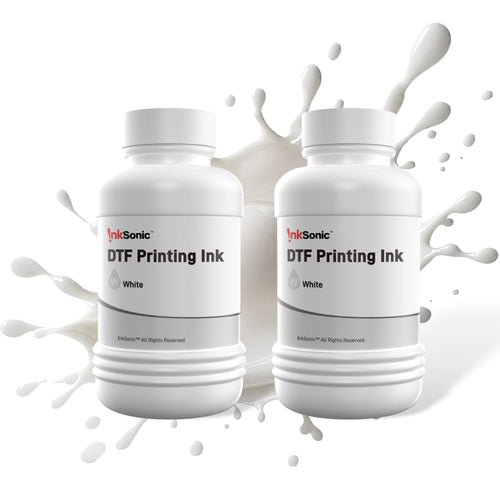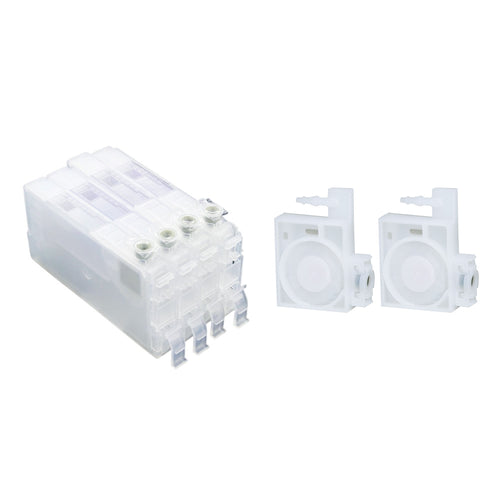DTF Supplies

Main Types of DTF Supplies
When it comes to DTF supplies, not all products are created equal.
DTF Inks
Quality of ink is crucial in DTF printing as the inks play the key role of image transfer and print quality.
When choosing DTF inks, the manufacturer declares that there are three aspects that need to be prioritized:
Color Vibrancy, in order for the ink to produce rich and vivid colors;
Durability, which means the prints can survive repeated washing without color bleed.
Compatibility, so the ink is compatible with their DTF printer model, to get the maximum output.
DTF Films
The DTF film is a foundation that is essential for your design. PET films are the most prevalent in the market because they are strong and clear. Films exist in different kinds, primarily distinguished by peel type—hot peel, which allows you to peel the film immediately after pressing, and cold peel, which requires the transfer to cool before peeling.
After choosing a DTF film, most customers have the following key factors in mind:
Print quality, where the film is of high clarity and resolution.
Ease of use, where they choose the release type that suits their heat press technique and desired finish;
Cost-effectiveness, where the quality vs. cost ratio is adequate, especially when high-volume printing is in question.
TPU Powders
TPU powders are essential to the DTF printing process as they attach the printed image to the garment, so consistent coverage is key to equal adhesion and durability throughout its lifespan.
The curing characteristics of the powder must be compatible with the heat press temperatures so that it melts and sticks according to temperature and pressure.
Proper storage in a low-humidity environment is also required to prevent clumping and maintain functionality.
In selecting TPU powders, most customers initially seek particle size and printing consistency, strong bond strength for repeated washing and wear, and ease of application (hand-applied or on a vibrating machine).
RIP Software
Raster Image Processor (RIP) software is a necessity for use with DTF printing because it takes your digital design and translates it into a usable format for your printer, in addition to color profiles, white under base application control, and even print head adjustment.
Best-selling for DTF Supplies
Are you worried that your DTF supplies are running out too fast, leaving you with incoming orders but not enough supplies to fulfill them? You're not alone—this is one of the most common concerns among DTF printer users, especially small business owners and home-based entrepreneurs.
DTF printing needs a consistent supply, either ink or film or TPU powder. When any of the various supplies run out unexpected in your DTF printing process, it puts the production in danger, in risk of a missed deadline, and brings the chance to find an alternative source for the customer's needs. The importance of forward planning and keeping on hand the most used items is clear.
That's why you don't need to worry, we have made it easy for you to stay prepared by showing you the most common DTF printer supplies our customers always buy together.
Necessary supplies in DTF printing process
When it comes to running a successful DTF printing operation, DTF ink, PET film, and TPU powder are the three core supplies that drive your daily production.
DTF ink provides the color and detail of your design while white ink typically gets laid down first and consumed much faster than color ink. Since it is laid down on nearly every print you make, it often tends to go quicker, with some production runs having it account for up to 60-70% of total ink usage. White ink is one of the most frequently replenished inventory items in a DTF business; therefore, allowing for fast and frequent restocking.
PET film serves as the transfer medium for designs, and it's essential to have a steady supply on hand, especially when fulfilling large or urgent orders. Running out of film mid-job can bring your production to a standstill. Similarly, TPU powder is crucial for bonding the ink to the fabric during the heat press stage, and without it, no transfer can occur.
To avoid unwarranted downtime or missed deadlines, you may want to consider having a little extra stock on hand. By having these essentials tracking stock, you are always prepared for rush orders, seasonal spikes in orders, or simply large volume jobs to make your DTF business more reliable, effective, and most importantly, profitable.
Why Choose Our DTF Powder, Film, and Ink?
Our DTF Powder
Our hot melt adhesive powder is compatible with all DTF printers and PET films, suitable for all materials such as cotton, polyester, blends, etc., with a particle size of ~80μm to ~200μm and strong adhesion.
Our DTF Transfer film
Our DTF transfer film is ready to work its magic on cotton or dark, leather, nylon, denim, polyester, or synthetic fibers, or any crazy mix of fabrics you can think of. Want a bit of sparkle? Choose our glow-in-the-dark or gold film options to add that little something extra.
Our DTF Ink
Our DTF Ink is like the VIP of the DTF Ink world. Crafted with a top-secret Japanese formula featuring German solvents, premium Japanese resins, and vibrant color pastes, it costs three times more than your average ink—but hey, you get what you pay for! We refine it through a three-level process to keep ink consumption low and quality during high-speed runs. Plus, we’ve added amino acids to keep it nice and moisturized, so your printhead never throws a tantrum from ink dryness.
Maximizing Your DTF Printing Success
Data shows that the following methods can significantly improve the success rate of DTF printing.
1. Regular Equipment Maintenance
Keep your printer clean: Make it a habit to clean the print heads and inside parts of your DTF printer. This avoids clogs and ensures a well-functioning printer.
Keep up to date: Always have your RIP software and printer firmware up to date so you can take advantage of new features and updates.
Check your supplies: Every now and then go over your films, inks, and powders to make sure nothing is spoiled or contaminated—spoiled supplies can destroy your prints.
2. Optimize Workflow
Organize Workspace: Organize supplies in a organized manner and under the correct environmental conditions.
Document Settings: Document heat press settings, print speeds, and other parameters that work best with your supplies. This documentation will be a godsend for troubleshooting and consistency.
Batch Processing: Print and cure in batches to streamline your production process and reduce downtime between jobs.
3. Get Involved in the Community
Join the DTF community: Join online forums and social media communities where many users share tips, advice, and help each other solve problems.
Take advantage of webinars: Vendors and industry professionals often offer free webinars and training courses to teach you how to use DTF equipment more effectively.
4. Try New Products:
Feel free to try new products or brands—just start with test prints. What works perfectly for somebody else might not work best for your machine.
Test and fine-tune your settings: Do wash tests every now and then to check your print quality, and tune in as needed. The more you do it, the better the prints get—pro level output takes time and calibration.












































